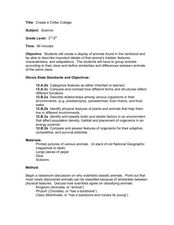Curated OER
Skulls Tell It All
Skulls tell it all, and with this lesson plan, you will tell it all to your class! Youngsters view animal skulls, analyzing the shape of teeth and the placement of the eye sockets. They associate these adaptations with the types of food...
Curated OER
Be Kind to Your Teeth
What kinds of food can be bad for your teeth? Kindergartners and first graders explore dental health with an interactive science inquiry. Given a choice of foods such as celery, cake, and milk, kids choose which ones are better for their...
Curated OER
Fossil Kit I - Lesson Plan
Here is a 14-page lesson plan that deftly outlines a wonderful educational experience for your youngsters. In it, students learn about a variety of animals that have left behind clues of their existence in fossil form. Many excellent...
Curated OER
Teeth and Eating
Young scholars conduct online research of different animals and their diet. In this animal activity, students identify the various types of diets each animals has and their teeth. This research is done on the Internet.
Curated OER
Teeth and Eating
Students examine pictures of different animals and decide if they eat meat and/or plants. They inspect models of pairs of upper and lower teeth and discuss which teeth are most useful for cutting grass and tearing meat.
Curated OER
Create a Critter Collage
Young scholars create a collage. In this animal classification lesson, students discuss why and how scientists classify animals. Young scholars view pictures of different animals and decide which class each animal belongs to. Students...
Science Geek
The Mole
What can you call a tooth in a glass of water? A one-molar solution! Presentation covers moles, Avogadro's Number, calculating formula mass, converting moles to grams, converting grams to moles, and calculations with moles. It is...
Curated OER
Eukaryotic Animal Cell, Candy Cell Model: Science
Middle schoolers review the parts of the eukaryotic animal cell and construct a model using various types of candy.
Curated OER
Animal Classification
Learners are introduced to the concept of classification as it relates to objects, information, and characteristics. In this classification lesson, students research a variety of animals. Learners study the Linnaeus's system of...
Curated OER
Teeth Identification in Omnivores, Herbivores and Carnivores
Young scholars practice identifying teeth. In this biology lesson plan, students explore the differences in teeth structure and how it determines what a specific animal eats by constructing a raccoon puppet.
Curated OER
Plankton in the Air
Here is a lab activity adequate for use with any full lesson on environmental factors that shape animal adaptations or marine animal characteristics. Pupils will discuss the role plankton plays in the environment and filter-feeding...
Curated OER
ESL Farm Animal Words
In this ESL farm animal words matching worksheet, students examine 5 clip art pictures of farm animals. They match the picture on the left with the word that names it on the right.
Curated OER
What Do We Learn From Fossils?
Students investigate what a fossil is and how it came to be. In this fossil lesson, students examine pictures of skeletons and identify characteristics that can and cannot be determined by a fossil. Students complete diagrams...
Curated OER
Ocean Exploration
Young scholars explore whales. In this animal adaptation and whale instructional activity, students access prior knowledge about whales from previous lessons, then use background knowledge to predict the eating strategies of a baleen...
Curated OER
Lesson 1 - What Are Fossils?
Learners define and research fossils. In this fossil lesson, students access teacher assigned Internet sites to examine images of fossils. They determine the definition of a fossil and find out how fossils are formed. They also define a...
Curated OER
Teeth and Eating
Learners explore animal diets and teeth. In this animal science lesson, students view photos of animals and their teeth. Learners identify the type of diet the animal has based on the teeth. Students are introduced to the terms...
American Museum of Natural History
Moving Mammals
How many different ways do mammals move from place to place? An online resource uses animation to show how different mammals move. Learners use a slider to speed up or slow down a variety of mammals. The versatile lesson works as a...
American Museum of Natural History
What's This? Leeches
Who actually likes leeches? Meet a scientist that makes his living letting leeches feed on him. Pupils learn about the characteristics of leeches and different variations of the species. The lesson works as a remote learning resource or...
Curated OER
ABC Safari
Students study the animals and their alphabet letter. In this animal alphabet lesson, students associate the animals with their letter and learn facts about the animals. Students may use the cards to classify animals by groups or play a...
Curated OER
Where Are the Dinosaurs?
Students recognize that they haven't seen a dinosaur because they no longer exist. In this dinosaur lesson, students view videos and understand what the dinosaur habitat was like. Students role play dinosaurs. Students explore dinosaur...
Curated OER
Shark Attack
Students study the white shark and the red triangle. In this critical thinking lesson plan students assess the validity of facts about sharks and create a public service announcement either promoting shark or human protection.
Curated OER
Classification
Learners complete an animal classification activity. In this classification lesson, students learn about the seven classification levels of animals. Learners are given several animal sheets in which they separate 12...
Curated OER
Animal Adaptation
Students begin the lesson by observing animals in their natural habitat. Using the internet, they research the types of adaptations they have gone through to be able to live comfortably in their environment. They observe what they see on...
Curated OER
Bug's Eye View
Investigate the life of bugs and how they interact with the environment in this integrated science and language arts lesson. Young scientists construct mini environments in cages in order to make observations. This data forms the basis...

























